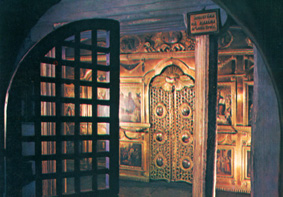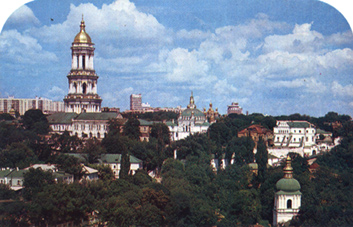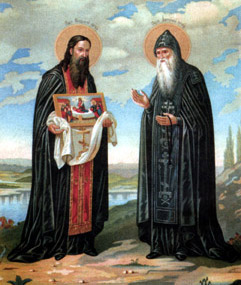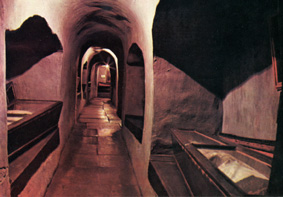| Go On Master Page | ||
| THE MYSTERIOUS UNDERGROUND CITY | ||
Kyiv for long has been famous for its monasteries. It is not accidental that Kyiv was dubbed the Jerusalem of the land of Rus. Pilgrims from all places and faraway parts of the vast empire came here on foot to pay divine honors to the city's holy places. The jewel in its crown was unquestionably the Kyiv-Pechersk Lavra of the Holy Assumption. | ||
| *** | ||
 Варлаамівськоїа церква у Ближніх печерах. Варлаамовская церковь в Ближних пещерах. St. Balaam's Church in the Near Caves. | ** |  Києво-Печерська Лавра. Вигляд зпівденного боку. Киево-Печерская лавра. Вид с южной стороны. The Kiev-Pechersk Lavra. View from the suuth. |
| *** | ||
To walk down its caves has always been considered a divine gift. The caves (pechery in Ukrainian) proper were what used to be the foundation of one of the oldest monasteries in the world. So they provided the name of the Monastery — Pechersky where, in the underground labyrinths, lie in peace the remains of people who made the history of this land. | ||
| PRESBYTER ANTHONIUS | ||
| Two chronicles which are known to us, throw light on the events related to the origin of the cave monastery, The Tale of Bygone Years and the Kyiv-Pechersk Paterikon. They are collected stories of the monks' lives compiled in the first half of the XIIIth century. |  Sts. Anthony and Theodosius of Pechersk | |
| The Tale has an entry under the year 1051, referring to a man of the city of Lubech who came to the Holy Mountain, took the vows and assumed the name of Anthonius. | ||
| Presbyter Anthonius arrived in Kyiv, visited different monasteries, but stayed in none of them. He then walked around in the forests and the hills looking for a place pointed out by the Lord. He found a small cave and stayed there, praying, eating plain bread every second day and drinking water just enough to survive, and deepening the cave. | ||
| MYSTERY OF DRIED-UP SKULLS | ||
| The myrrh-oozing heads have always been most intriguing among the cave relics. These dried-up skulls are kept in a glass or nickel-plated vessel with a lid on top. The heads exude a myrrh (oil) considered to be a remedy for different diseases. |  | |
| They were first mentioned by foreign travelers who visited the Monastery in the XVIth century. On the map drawn by A. Kalnofoisky, the Near Caves were shown as the place they were kept. In the latter half of the XVIIIth century, the heads also appeared at the Far Caves. | ||
| In the first half of the XXth century, they were only at the Far Caves where they can be seen today. Vessels with the myrrh-oozing heads lie on shelves and are locked up behind copper-plated doors. | Ближні печери. Коридор з похованнями. Ближние пещеры. Коридор с захоронениями. The Near Caves. Gallery with the relics. | |
| Go On Master Page | ||